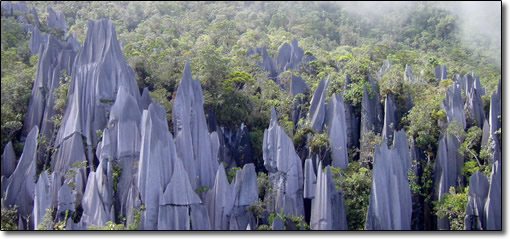
Gunung Mulu National Park
“Captain Dave”, a bush pilot for Malaysian Airlines, runs a guesthouse in Miri that is the nerve center for local information. He hooked us up with “Willie” Kajan, a guide and native rights activist from Gunung Mulu National Park. The park protects a spectacular system of limestone caves as well as good lowland tropical forest. Willie, a member of the local tribe, had been arrested for protesting again outside concessions that did not benefit the traditional inhabitants. The park has a few good treks, especially the “pinnacles”. The pinnacles are spikes of sharp limestone rock, created by wind and rain erosion, on the side of a mountain. The best way to get to Mulu from Miri is by plane. After rising in the air above Miri, we could again see the clear signs of deforestation. But, off to the left, appeared an unbroken stretch of perfect forest. This is Brunei. We flew over a magnificent stretch of unbroken canopy, with not a road or a dwelling in sight. The border with Sarawak was clearly visible: the forest ended abruptly as we swooped in past a limestone hillock to land in Mulu. Willie brought us immediately to the boat that would take us upstream to the pinnacles trailhead. We had just a short time to repack our bags and take what we needed. The boat pushed off and sped upriver, but soon we ran aground and had to jump out to push. Willie was right to be nervous: dark clouds were approaching. It rained every day at about 2 pm, and today was no exception. Just as we reached the landing point, it started to pour. Still 8 km from camp, we shouldered our bags and took off into the forest. Everything was thoroughly soaked. By the time we arrived, it had stopped raining. We wrung out our clothes, switched to a dry set, and settled in to cook dinner. The pinnacles is a popular trek, and there were plenty of people staying in the camp. Willie sat us down after cooking dinner and gave us a serious briefing, explaining that the trek was dangerous and that it was important to reach the base of the summit by 11 am to allow enough time to descend. We tried to sleep the best we could in the damp, muggy heat.
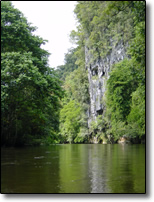 |
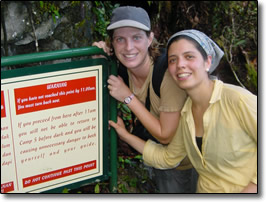 |
In the morning we attacked the trail and quickly passed the other groups ahead of us on the ascent. We reached the point of no return with plenty of time to spare, and continued as the trail scrambled over rocks and up aluminum ladders to the pinnacles viewpoint. On arrival, we spread out to enjoy the view of the polished limestone crags. Clouds rolled in, obscuring the pinnacles with a thick white cover. Willie, who arrived a bit after us, secluded himself away from the group on a limestone outcropping. When I went over to see how he was doing, he smiled sheepishly, peering down at his mobile phone while moving his thumb frantically over the keyboard. It was the only place he could get good reception. Going down the steep, limestone-studded trail was more difficult than climbing. About halfway down it started to rain, making the exposed limestone slippery and requiring extra caution. When we arrived back in camp, a dip in the stream and a plate of cookies was just the thing. That night, after dinner, Willie took us into the jungle on a night walk. With our lights we spotted a long, black-and-yellow mangrove snake hunting in a stream.
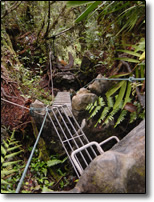 |
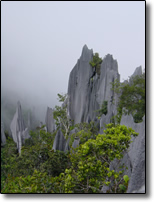 |
By now our clothes, exposed to the constant damp, had started to smell, as if a kind of mold had grown on them. It was impossible to get things to dry. At least we all smelled equally bad. Vera broke out with an itchy rash on her legs and stomach. Pretty soon we all had it, although the cause was a mystery. Some people said it was due to pollen, others thought exposure to some kind of jungle plant or tree. Strange, as we had never had anything like it before. It kept us scratching for a couple of weeks. Back at Mulu headquarters, Willie took us on a tour of the four principal Mulu caves. It was impressive how varied the different “show caves” were. Some were like long tunnels with little formations, while others were filled with baroque mounds and stalactites. Deer cave, though, is incredible. It is simply huge. Inside we followed the boardwalk through the cave. The roof soared above us, like the inside of giant hangar. Looking back, we could see the famous “Abe Lincoln” profile of the cave entrance against the darkening sky. At the end of the boardwalk, on a wooden platform, was a view of the “Garden of Eden”, a patch of jungle visible through a hole in the limestone wall.
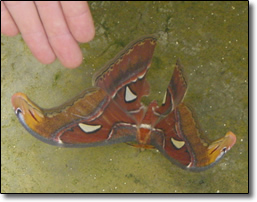 |
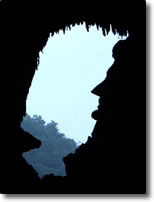 |
A column of water poured down from the roof high above. The thick, sharp smell of guano pervaded the air. As we swung our lights around the platform, we could see small, naked baby bats clinging to the wooden posts. The bats, having fallen out of their nests on the ceiling high above, were being eaten alive by small earwigs. Not only were we thoroughly disgusted, but we also started to look down at our sandaled feet carefully. Creeping earwigs were already trying to climb aboard! We hurried for the exit, trying not to slip on the wet guano that covered the trail. Outside, it was raining again. Because of the bad weather, it was not possible to see the exodus of bats that takes place at dusk every day. On the way back to park headquarters Willie pointed a poison tree out to us. The trunk was scarred where collectors had taken the sap, used as the active ingredient by the Penan for their deadly blowgun darts. Back in our guesthouse, as I took off my wet pants, I felt a tickling sensation on my thigh. An earwig from the cave had worked its way up my leg!
 |
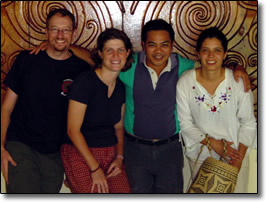 |
